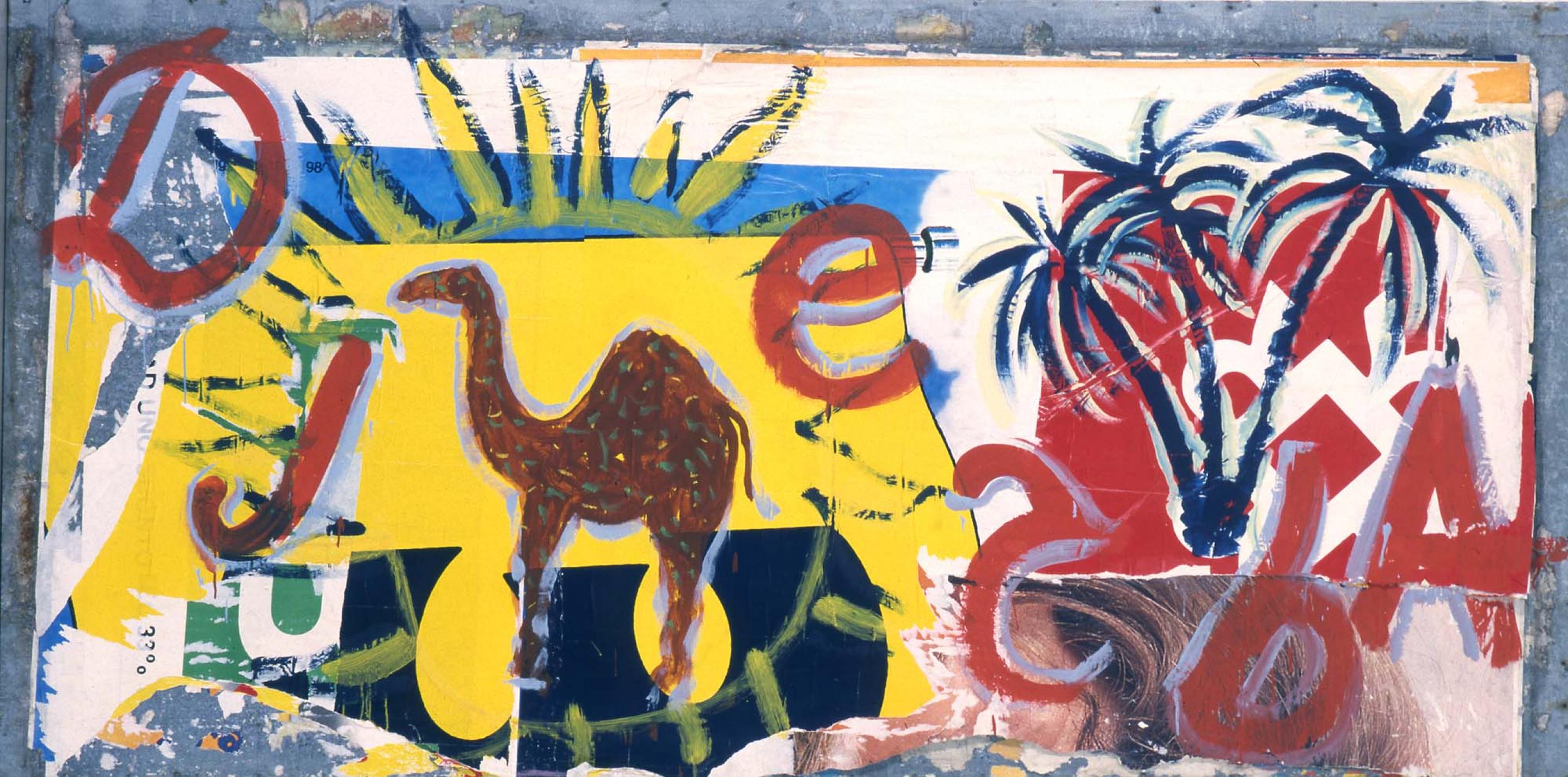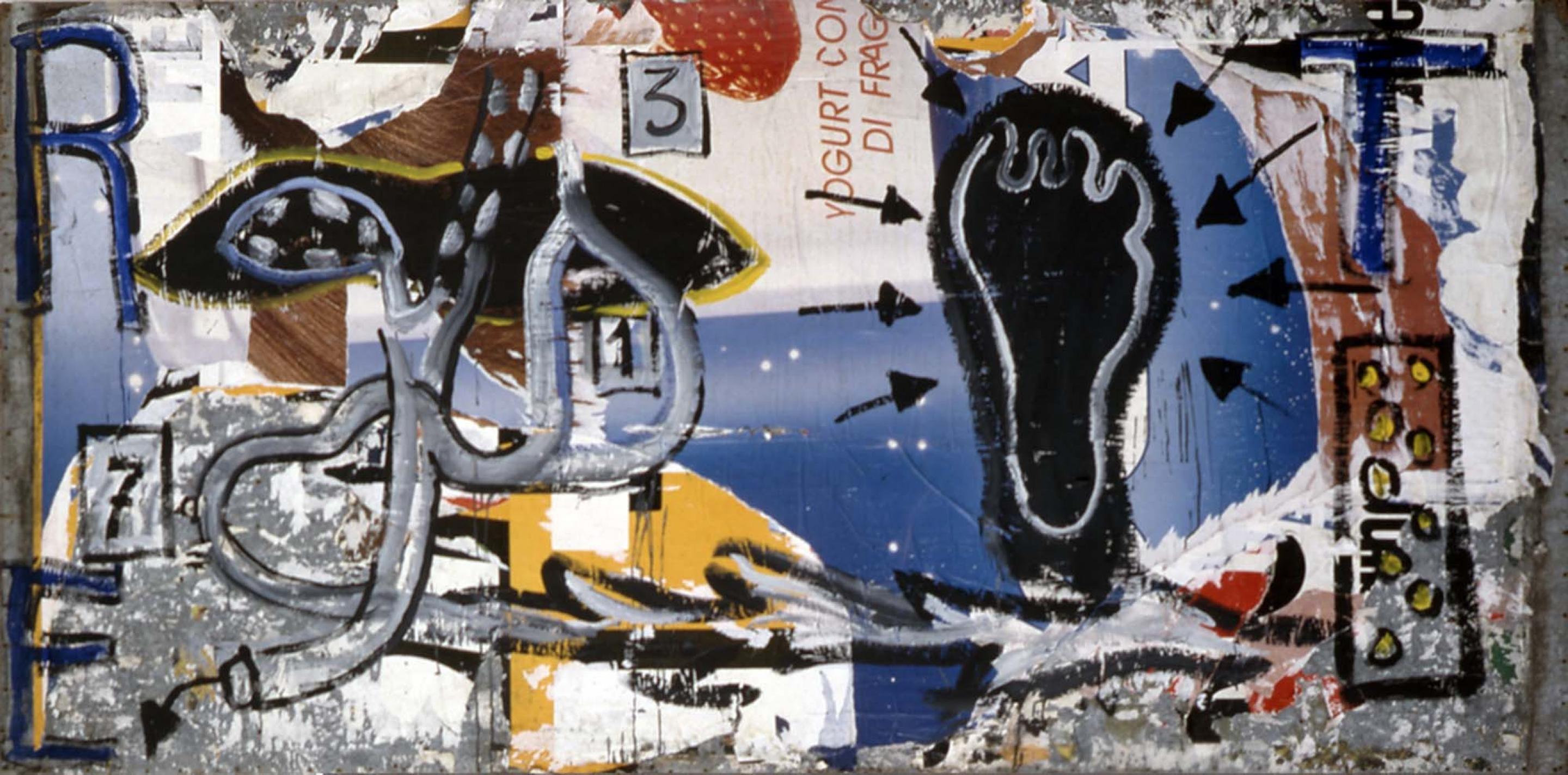MimmoROTELLA
About
Though Mimmo Rotella did not invent collage as he would have liked to, he was the creator of décollage, exactly the opposite of collage.
Originally “abstract”, Rotella’s décollages developed until 1960, when the recuperation of the figurative image became their predominant feature.
Apart from being a clear admission of dissent against traditional painting, the action of removing posters from the walls of the city was a sort of "research that doesn’t rely on aesthetics but on the unexpected, on the same moods as the material", stated Rotella and it disclosed him the complexity of reality, and the possibility of casually overlapping different stories, messages, signs and colours as manifestations of urban life.
Mimmo Rotella was born in Catanzaro in 1918. After graduating from the Academy of Fine Arts in Naples, in 1945 he moved to Rome.
1949 saw the creation of his first phonetic poems, the Epistaltici. Awarded a Fulbright Foundation scholarship, between 1951-52 he was a resident at the University of Kansas City, and in 1953 began making his first décollages.
In 1955 he held his first solo exhibition as a décollage artist at the Galleria del Naviglio in Milan. During the second half of the Fifties he began to devote himself to figurative décollage, which led to the Cinecittà series made using film posters.
He chose Marilyn Monroe as the main female subject, thus contributing to her mythical status and making her an icon of his work.
In 1960 he was invited by the critic Pierre Restany to join his Nouveau Réalisme group, founded the previous year. Rotella exhibited at Galerie J in Paris, the Festival du Nouveau Réalisme, and the major exhibition The Art of Assemblage at the MoMA, New York.
In 1963 he began his first Mec Art works.
The following year he was given a room at the 32nd Venice Biennial.
In 1966 he exhibited his first artypos (printing proofs reproduced on canvas) at the Teatro La Fenice in Venice and at the Galerie Zunini in Paris.
In 1970 he began to create his effaçages and frottages. In 1972 he published his first autobiography, Autorotella: Autobiografia di un artista, and soon afterwards prepared the collection of his phonetic poems.
After definitively settling in Milan in 1980, he began to develop his blanks: torn advertising posters he covered with monochrome strips of paper. These were presented at the Galerie Denise René in Paris and at Studio Marconi, Milan in 1981.
He took part in the Italian Art 1960-1982 exhibition organised at the Hayward Gallery in London, and in the 1986 group show Les Nouveaux Réalistes at the Musée d'Art Moderne de la Ville de Paris. In 1986 he produced his first sovrapitture: figures, symbols and graffiti on torn posters glued onto sheet metal panels.
In the Nineties he took part in several group shows, such as: Italian Art in the 20th Century 1900-1988 and Pop Art at the Royal Academy in London; Art et Publicité at the Centre Pompidou in Paris; High and Low at the MoMA and Italian Metamorphosis at the Guggenheim Museum, New York.
Many museums and other venues have held important anthologies and retrospectives of his work, such as the one organised at the Musée d’Art Moderne et Contemporain in Nice (1999).
In 2000 the artist set up the Mimmo Rotella Foundation, presently under the presidence of Rocco Guglielmo and the direction of Piero Mascitti.
In 2001 he was dedicated a solo room at the Venice Biennial curated by Harald Szeemann; in 2005 some of his large-sized works were displayed at the Tinguely Museum in Basel and at the Palais des Nations Unies in Geneva in the exhibition entitled Mimmo Rotella. Avenue Rotella (2005) and curated by Germano Celant.
Mimmo Rotella died in Milan on 8 January 2006.
His work is still shown on numerous occasions at prestigious museums in Italy and abroad. Important among these was the group show Nouveau Réalisme, organised in 2007 at the Galeries Nationales du Grand Palais in Paris and revived at the Sprengel Museum in Hannover.
In 2008, the Scuderie del Quirinale in Rome hosted the exhibition Pop Art 1956-1968, and the GAM in Turin presented Collage/Collages dal Cubismo al New Dada.
The same year saw the exhibitions Mimmo Rotella. Lamiere, curated by Alberto Fiz at the MARCA, Catanzaro, and Europop at the Kunsthaus, Zurich.
In 2009 Rotella’s work was shown at the exhibitions Italics. Arte italiana fra tradizione e rivoluzione 1968-2008, curated by Francesco Bonami at Palazzo Grassi in Venice, and Nouveau Réalisme dal 1970 ad oggi, at the PAC in Milan, curated by Renato Barilli.
Finally, in 2014 a wide retrospective Mimmo Rotella. Décollages e retro d'affiches was held at Palazzo Reale, Milan.
In 2016 the Marconi Foundation dedicated to the artist’s work the homage Mimmo Rotella e Giorgio Marconi. Una storia d'arte e di amicizia, which coincided with the tenth anniversary of his death and was organised on the initiative of the Mimmo Rotella Institute.
Originally “abstract”, Rotella’s décollages developed until 1960, when the recuperation of the figurative image became their predominant feature.
Apart from being a clear admission of dissent against traditional painting, the action of removing posters from the walls of the city was a sort of "research that doesn’t rely on aesthetics but on the unexpected, on the same moods as the material", stated Rotella and it disclosed him the complexity of reality, and the possibility of casually overlapping different stories, messages, signs and colours as manifestations of urban life.
Mimmo Rotella was born in Catanzaro in 1918. After graduating from the Academy of Fine Arts in Naples, in 1945 he moved to Rome.
1949 saw the creation of his first phonetic poems, the Epistaltici. Awarded a Fulbright Foundation scholarship, between 1951-52 he was a resident at the University of Kansas City, and in 1953 began making his first décollages.
In 1955 he held his first solo exhibition as a décollage artist at the Galleria del Naviglio in Milan. During the second half of the Fifties he began to devote himself to figurative décollage, which led to the Cinecittà series made using film posters.
He chose Marilyn Monroe as the main female subject, thus contributing to her mythical status and making her an icon of his work.
In 1960 he was invited by the critic Pierre Restany to join his Nouveau Réalisme group, founded the previous year. Rotella exhibited at Galerie J in Paris, the Festival du Nouveau Réalisme, and the major exhibition The Art of Assemblage at the MoMA, New York.
In 1963 he began his first Mec Art works.
The following year he was given a room at the 32nd Venice Biennial.
In 1966 he exhibited his first artypos (printing proofs reproduced on canvas) at the Teatro La Fenice in Venice and at the Galerie Zunini in Paris.
In 1970 he began to create his effaçages and frottages. In 1972 he published his first autobiography, Autorotella: Autobiografia di un artista, and soon afterwards prepared the collection of his phonetic poems.
After definitively settling in Milan in 1980, he began to develop his blanks: torn advertising posters he covered with monochrome strips of paper. These were presented at the Galerie Denise René in Paris and at Studio Marconi, Milan in 1981.
He took part in the Italian Art 1960-1982 exhibition organised at the Hayward Gallery in London, and in the 1986 group show Les Nouveaux Réalistes at the Musée d'Art Moderne de la Ville de Paris. In 1986 he produced his first sovrapitture: figures, symbols and graffiti on torn posters glued onto sheet metal panels.
In the Nineties he took part in several group shows, such as: Italian Art in the 20th Century 1900-1988 and Pop Art at the Royal Academy in London; Art et Publicité at the Centre Pompidou in Paris; High and Low at the MoMA and Italian Metamorphosis at the Guggenheim Museum, New York.
Many museums and other venues have held important anthologies and retrospectives of his work, such as the one organised at the Musée d’Art Moderne et Contemporain in Nice (1999).
In 2000 the artist set up the Mimmo Rotella Foundation, presently under the presidence of Rocco Guglielmo and the direction of Piero Mascitti.
In 2001 he was dedicated a solo room at the Venice Biennial curated by Harald Szeemann; in 2005 some of his large-sized works were displayed at the Tinguely Museum in Basel and at the Palais des Nations Unies in Geneva in the exhibition entitled Mimmo Rotella. Avenue Rotella (2005) and curated by Germano Celant.
Mimmo Rotella died in Milan on 8 January 2006.
His work is still shown on numerous occasions at prestigious museums in Italy and abroad. Important among these was the group show Nouveau Réalisme, organised in 2007 at the Galeries Nationales du Grand Palais in Paris and revived at the Sprengel Museum in Hannover.
In 2008, the Scuderie del Quirinale in Rome hosted the exhibition Pop Art 1956-1968, and the GAM in Turin presented Collage/Collages dal Cubismo al New Dada.
The same year saw the exhibitions Mimmo Rotella. Lamiere, curated by Alberto Fiz at the MARCA, Catanzaro, and Europop at the Kunsthaus, Zurich.
In 2009 Rotella’s work was shown at the exhibitions Italics. Arte italiana fra tradizione e rivoluzione 1968-2008, curated by Francesco Bonami at Palazzo Grassi in Venice, and Nouveau Réalisme dal 1970 ad oggi, at the PAC in Milan, curated by Renato Barilli.
Finally, in 2014 a wide retrospective Mimmo Rotella. Décollages e retro d'affiches was held at Palazzo Reale, Milan.
In 2016 the Marconi Foundation dedicated to the artist’s work the homage Mimmo Rotella e Giorgio Marconi. Una storia d'arte e di amicizia, which coincided with the tenth anniversary of his death and was organised on the initiative of the Mimmo Rotella Institute.












